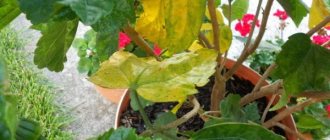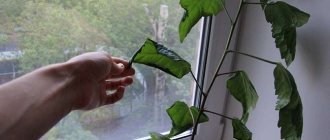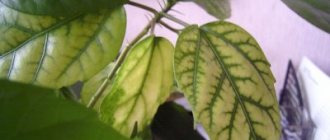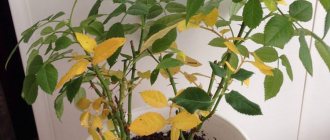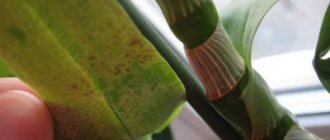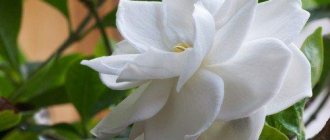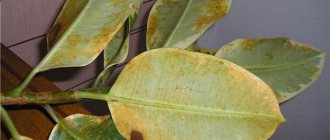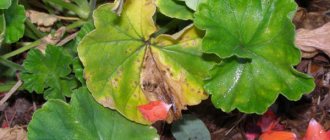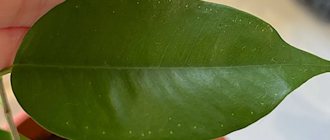Chinese hibiscus (Hibiscus rosa-sinensis) is a heat-loving species of the Hibiscus genus from the Malvaceae family. In Russia and neighboring countries, this is a popular indoor plant, better known as the Chinese rose. It is a large evergreen shrub with quickly woody branches, shiny dark green plates, and large flowers that look like bright gramophones. Care is simple; many owners consider the plant to be problem-free and pay little attention to it. But when the leaves of a Chinese rose turn yellow and fall off, you will have to look for the source of trouble.
Natural causes
Hibiscus does not have a pronounced dormant period, but at the end of the season the plant sheds some of its leaves. This is normal in the following cases:
- Chinese rose over 2 years old;
- yellowing and flying vegetative organs make up no more than 5-10% of the total mass of leaves.
Each plate does not live indefinitely. At home, even with proper maintenance, the leaves age, turn yellow and fall off within 2-3 years.
This usually occurs in the fall, starting from the base of the lower branches of the older order. In spring, new vegetative buds bloom on young growth, so that the volume of green mass constantly increases.
But sometimes the Chinese rose drops its leaves at the beginning or middle of the season. If this is not widespread - 1-2 plates have fallen, the plant looks healthy, blooms, there is nothing to worry about. But when real leaf fall begins, you need to urgently look for the cause.
Treatment of diseases
Treatment of hibiscus consists of eliminating the causes of the disease, in accordance with the recommendations indicated above.
To prevent deterioration of the flower in the future, you must adhere to the following conditions for its maintenance:
- Water as the top layer of soil dries.
- Choose the location of the pot or planting site based on the location of the hibiscus in light shade.
- Fertilize once a week from the beginning of the growing season until mid-August. Subsequently, the period increases to one month.
- Watering in the cold season is reduced. It is better to place the container with the plant in a room with a temperature of +15 degrees.
- Spraying is carried out daily in the summer.
- Before planting, the bottom of the hole or the bottom of the pot is paved with a drainage layer. When growing in a container, it is important to carry out timely replanting to renew the soil.
Care errors
Often the owners are to blame for hibiscus leaves turning yellow or drying out. This is one of the easiest woody indoor plants to grow, so they pay little attention to it and do not take into account the requirements of agricultural technology.
Until a certain point, such neglect remains without consequences, then the leaves begin to fall.
Wrong landing site
Chinese hibiscus is not planted in open ground in garden plots. In the post-Soviet space, this is not a street plant, but an exclusively indoor plant. The culture is very demanding of heat, it suffers when the thermometer drops to 12° C, and can die at a temperature of 10° C. But first, the leaves of the Chinese rose turn yellow and fall off.
Usually Hibiscus rosa-sinensis is not confused with Syrian hibiscus overwintering in the ground, especially with herbaceous species. But in the summer, the owners can take the tree outside, and place it not in a quiet corner, but in the most visible, open place, and even next to inappropriate neighbors. And there is sheer stress: drafts, temperature changes, diseases and pests that the crop cannot infect at home. The result is yellowing and falling leaves.
Watering and air humidity
This is one of the common reasons why hibiscus leaves turn yellow. Uneven irrigation, excess or lack of water are equally likely to lead to problems.
More often, over-drying occurs in a cramped pot, and over-watering occurs if the container is too large.
To correct the situation, you need to adjust the watering. You may need to repot your hibiscus into fresh substrate and a suitable sized pot.
Overdrying of the soil
Due to dry soil, some of the thin adventitious roots will certainly die, and as a result, the leaf blades turn yellow. It usually doesn’t get to the point where they start to dry out - the vegetative organs fly around earlier.
Rare watering and systematic drying of the soil do not allow nutrients to be fully absorbed, which also causes yellowing of the Chinese rose.
Hibiscus is a large woody plant; it may simply not have enough water even with regular watering. The earthen lump should be completely saturated, and excess liquid should come out into the pan. If accidental overdrying occurs, the substrate has hardened and does not want to absorb moisture, you need to place the pot in a bucket of warm water (it should not reach the edge of the container). A sign that the lump is “drunk” is a wet soil surface.
Overmoistening of the substrate
From overflowing, hibiscus leaves usually do not turn yellow at first, but wither. The soil becomes compacted or turns into a swamp, oxygen does not reach the roots, which causes the death of the lower shoots and promotes the development of putrefactive bacteria.
The plates began to turn yellow from overwatering, which means that problems with the root have already begun. You need to remove the hibiscus from the pot and inspect the underground part:
- if the soil is good and the lower shoots are alive, dry the lump on newspaper and return it to the container;
- the roots began to rot - peel back to healthy tissue, disinfect, transplant into a new pot of a suitable size, fresh soil, treat with a stimulant.
Other watering problems
Sometimes the leaves turn yellow due to the quality of the water - the soil becomes saline and loses permeability. Tap water must be settled, boiled or frozen. The whitish coating is removed from the earthen clod, and fresh substrate is added to the pot.
Watering with cold water, especially in hot weather, causes stress to the root. Some hibiscus leaves fly off, some turn yellow.
Sometimes owners do irrigation incorrectly during the dormant period. They said to cut back, they reduce the amount of water or water the hibiscus less often. But, if the room is hot and the plant is standing next to heating devices, this will certainly lead to the loss of some leaves.
Low air humidity
Hibiscus needs regular spraying of the crown, especially in the heat of summer, if it stands close to the radiator in winter. The water should be warm and soft. With low air humidity but normal watering, the leaves wither and wrinkle, although they usually do not change color.
Lighting
The Chinese rose needs bright diffused light with protection from direct rays. Under active sun, the plates first turn pale and then turn yellow. If the crown is sprayed in the late morning, or the pot is placed close to the glass, the leaves may burn.
Over time, the hibiscus grows and becomes large. You can’t keep it on the windowsill anymore; there’s not always room nearby. So they put the bush in the back of the room.
The first sign of lack of light is no flowers. The plant itself remains attractive for a long time, but over time more and more leaves turn yellow. In deep shade the process goes much faster than in partial shade.
Chinese rose can grow under artificial light.
Temperature
Hibiscus leaves turn yellow due to extreme heat, especially accompanied by drying out of the earthen clod. The temperature comfortable for the crop is 18-22° C. In winter the flower can withstand 14-16° C, in summer with regular spraying – up to 30° C.
If the thermometer rises higher and there is no air conditioning in the room, many gardeners do not know what to do. It is necessary to increase air humidity, but on an ongoing basis, and not by spraying the crown.
Bowls with water placed around or wet pebbles on a tray help little, especially when the hibiscus is large - without pruning at home it can grow up to 2 m. It is best to buy an indoor fountain or a household humidifier.
The cold causes the leaves to turn yellow and fall off. During a cool winter, you need to make sure that the temperature does not fall below 12-13 ° C, limit watering, and stop spraying.
The leaves of the Chinese rose turn yellow due to overheating of the earthen ball, especially in a dark pot. When at the same time the plant is overdried or water stagnates in the container, the problem is aggravated, the root system suffers more, and the fact that the hibiscus sheds its leaves is the least of the troubles. If the situation is not corrected urgently, the flower may die. In hot weather, a container that is dark or standing close to the window glass is wrapped in foil if it is impossible to move the flower to the side.
Temperature changes are no less dangerous. To avoid leaf fall and yellowing, many owners do not expose Chinese roses to fresh air in the summer.
Reasons related to fertilizing
From a lack of nutrients, hibiscus can develop non-infectious chlorosis. The disease is expressed in a violation of the formation of chlorophyll and a decrease in photosynthesis.
Characteristic features:
- leaves turn yellow;
- young plates become smaller;
- the tops of the shoots dry out;
- roots die.
Most often, the Chinese rose turns yellow due to a lack of:
- nitrogen - color changes starting from old leaves;
- gland - manifested by interveinal chlorosis;
- manganese - comes from the base of the plate;
- boron - vegetative organs do not turn yellow, but become pale;
- calcium - occurs when watering exclusively with purified water, accompanied by deformation of the leaves.
Hibiscus should be fed with mineral fertilizers containing microelements. As soon as the bush begins to turn yellow, treat the crown with a chelate complex.
Chlorosis can be caused by exposure to sulfur dioxide (acid rain), as well as by the fact that nutrients are in the soil, but are not absorbed. Causes:
- damage to the root system;
- watering with saline or chlorinated water;
- acidic substrate;
- incorrect balance of elements, which happens when owners do not use complex preparations, but mix single-component fertilizers themselves.
Stress factors
Any deviation from agricultural technology is stressful for plants. In addition to the reasons discussed above and those that will be discussed a little later, hibiscus leaves turn yellow:
- drafts;
- relocation to another place;
- sudden change in conditions of detention;
- treatment with pesticides if the owners exceeded the concentration of the drug or the number of sprays specified in the instructions.
Hibiscus leaf diseases
The photos presented on the page clearly demonstrate the effect of diseases on the leaf blade of the plant.
Changes in leaves are mainly caused by chlorosis. When it occurs, the amount of chlorophyll produced decreases. Let's look at the most common symptoms and the causes of their occurrence:
- Yellowing of the leaf blade. Occurs due to the fault of pests, the presence of diseases of the root system (including rotting), chlorosis, dry indoor air (often when central heating is turned on or heaters are used).
- Dropping greenery. The reason is insufficient humidity, lack of spraying in the heat, dramatic changes in lighting, and the presence of drafts. Other stresses, such as replanting, severe pruning, etc., can also have a negative impact.
- Rolling leaves into a tube. Occurs due to the appearance of pests that suck out the juice.
- Wilting of leaves. Wanting to understand what to do when hibiscus leaves wither, you need to pay attention to the temperature and humidity of the air. The symptom manifests itself in extreme heat and when humidity decreases.
- Wilting of the tip of the leaf blade. It will be necessary to add nutrients to the soil. This problem can be caused by a lack of nitrogen, phosphorus and other mineral elements.
- Falling buds and leaves. The problem occurs when there is a lack of potassium, the plant is affected by gall midges, or the temperature in the room is high.
Reasons associated with transplantation
An adult hibiscus is a large bush with rather thick woody branches and a developed root system. Any transplant is a difficult test for him, even if it is not accompanied by the destruction of the earthen coma.
After the operation, the Chinese rose is sick for a long time, it is recommended to help the plant:
- pour stimulants under the root that promote the regeneration of the lower processes;
- spray the crown with anti-stress medications.
It is recommended to replant hibiscus using the transshipment method.
Root damage
Injured roots work worse or stop functioning completely during the recovery period. This is especially pronounced in woody plants, such as Chinese hibiscus. The above-ground organs receive insufficient water and nutrients. To reduce the load, flowers and buds fall off first, then the plates turn yellow and fall off.
After the root system is restored, the bush acquires new leaves.
Wrong potty
In a small container it is difficult to provide normal watering or fertilizing - almost all the soil there has been replaced by the root system. Hibiscus often dries out.
The substrate in a large pot is usually waterlogged and may turn sour. The roots suffer from a lack of oxygen and often begin to rot.
Hibiscus leaves will turn yellow if the container does not have holes or drainage at the bottom.
Unsuitable substrate
Chinese rose needs soil that is permeable to water and air, with a neutral reaction. In acidic or alkaline conditions, the plates turn yellow and fly off. A substrate that is too dense or heavy will not suit hibiscus.
Hibiscus drops leaves due to improper watering
Hibiscus over four to five years old needs a large amount of irrigation water daily, as its root system requires it. During the break between watering, the soil in the flower pot should not be wet, but always slightly moist.
Stagnant water and swampy soil create favorable conditions for the appearance of harmful bacteria and various fungal diseases. The root system no longer has enough nutrients for the growth and development of the flower, so the leaves begin to turn yellow and gradually fall off. This process must be stopped at an early stage, then the hibiscus can still be saved.
Using hedgehogs to process potatoes
Types of seedling cassettes and their use
Hazelnut - how it grows and blooms, growing a nut in the garden
Usually a young plant cannot cope with heavy watering. It is recommended to urgently remove it from the flower container, wash the roots, all rotten and blackened parts must be completely cut off. Then you need to treat all cut areas and the remaining roots with fungicides, sprinkle with the preparation “Kornevin” and transplant the indoor flower into a new flower container and fresh substrate. Immediately after planting, you need to spray the entire crown of the Chinese rose with a solution based on Epin.
Infectious diseases and pests
Like most tree crops, Chinese hibiscus is a vigorous plant. But insects or infections can become a real problem, especially for weakened specimens.
Hibiscus pests
The bush must be inspected regularly in order to promptly detect infestation with insects or mites (these are arachnids). They drink cell sap from vegetative organs, which causes the leaves to turn yellow and eventually fall off.
Hibiscus suffers from pests:
- The scale insect looks like growths covered with a waxy coating;
- the mealybug is inactive, likes to settle in the axils of leaves, where it forms nests similar to cotton wool or saliva;
- aphids adhere to young vegetative organs, secrete a sticky secretion - a nutrient medium for disease-causing fungi and bacteria;
- the spider mite is not noticeable to the naked eye, it settles on the back side of the plates, covering it with a thin web;
- the whitefly becomes a real disaster in greenhouses, greenhouses, it flies, its body is covered with a powdery coating;
- thrips run and jump well, prefer unopened buds, but if they are “over”, they suck the juice from the plates.
When the leaves of a Chinese rose turn yellow and fall off due to pest infestation, the bush must be treated with an insecticide. Actelik is usually used to treat indoor plants - it has an acaricidal effect and is suitable not only for killing all insects, but also mites.
More about pests: spider mites on hibiscus
If the air in the room is dry and spraying is not carried out regularly, then good conditions may arise for the development of mites on hibiscus; their colonies multiply quickly, feeding on the juice from the leaves.
The appearance of a spider mite can very quickly completely destroy a plant, so you need to know the characteristic signs of its presence. First of all, these are spots on the leaves; they can be brown or black; in fact, they represent the excrement of the pest. The upper parts of the leaves are completely covered with small yellowish spots, the affected leaf loses its natural color, then becomes covered with a network of cobwebs, then falls off. Mites migrate along the web and destroy the entire plant.
For prevention, you need to monitor the air humidity in the room, spray the hibiscus regularly, avoiding dryness.
To combat the pest, both folk remedies (liquid soap, onion or garlic solution) and chemical preparations are used, spraying every five days. It should be remembered that you need to rid the plant of the parasite before it goes to rest for the winter. Otherwise, ticks will appear again in the spring.
So, if you carefully observe all the necessary conditions for growing a healthy plant, then it is unlikely that diseases and pests will bother your hibiscus that much. Proper care is the key to an attractive appearance, rich flowering, as well as strong immunity, which will help the plant cope independently even with an invasion of pests.
Diseases caused by improper care: sunburn
Yellow spots on the leaves may be the result of sunburn. When choosing a place for a plant, you need to remember this. Usually, the Chinese rose tolerates sunlight well, but if you place a flower accustomed to shade in the bright sun, hibiscus leaf disease cannot be avoided. Dry yellow spots appear on them. They can also occur in places that are pressed against the glass. To avoid this, experts recommend accustoming hibiscus to sunlight gradually. Affected leaves with dry areas will have to be removed.
It is also necessary to know that changes in the color of leaves and the appearance of spots on them may be associated with a lack of certain substances in the soil. For example, if there is a lack of an element such as zinc, the leaves may become speckled and shredded. If the edges turn brown, the plant does not have enough sulfur. Marbling of the leaves, in which there are white spots between the veins, indicates a lack of magnesium. If the hibiscus lacks potassium, the leaves may begin to die at the edges. In addition, the plant will not bloom well.
You may be interested in: Indoor flower with large leaves: description with photos, flower names and care recommendations
